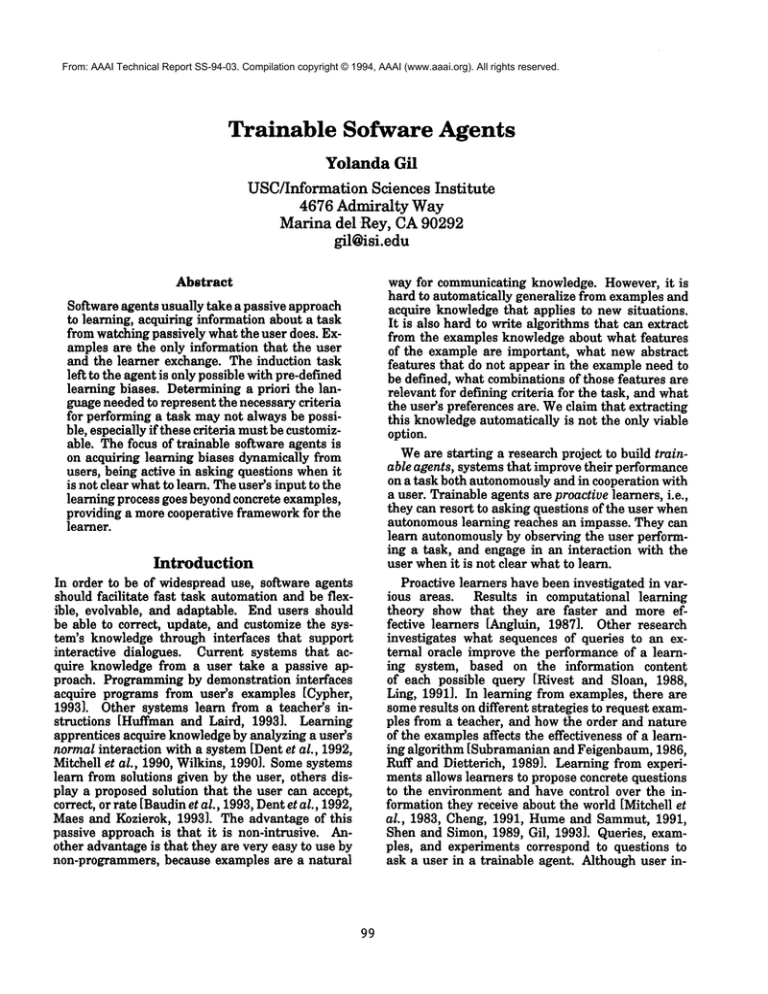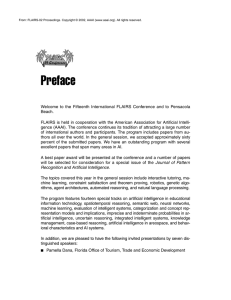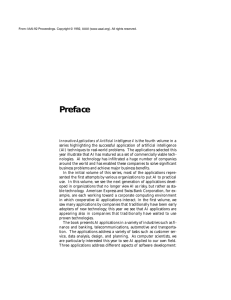
From: AAAI Technical Report SS-94-03. Compilation copyright © 1994, AAAI (www.aaai.org). All rights reserved.
Trainable
Sofware Agents
Yolanda
Gil
USC/Information
Sciences Institute
4676 Admiralty
Way
Marina del Rey, CA 90292
gil@isi.edu
Abstract
way for communicating knowledge. However, it is
hard to automatically generalize from examples and
acquire knowledge that applies to new situations.
It is also hard to write algorithms that can extract
from the examples knowledge about what features
of the example are important, what new abstract
features that do not appear in the example need to
be defined, what combinations of those features are
relevant for defining criteria for the task, and what
the user’s preferences are. Weclaim that extracting
this knowledgeautomatically is not the only viable
option.
Weare starting a research project to build trainable agents, systems that improve their performance
on a task both autonomouslyand in cooperation with
a user. Trainable agents are proactive learners, i.e.,
they can resort to asking questions of the user when
autonomous learning reaches an impasse. They can
learn autonomously by observing the user performing a task, and engage in an interaction with the
user whenit is not clear what to learn.
Proactive learners have been investigated in various areas. Results in computational learning
theory show that they are faster and more effective learners [Angluin, 1987]. Other research
investigates what sequences of queries to an external oracle improve the performance of a learning system, based on the information content
of each possible query [Rivest and Sloan, 1988,
Ling, 1991]. In learning from examples, there are
someresults on different strategies to request examples from a teacher, and howthe order and nature
of the examplesaffects the effectiveness of a learning algorithm [Subramanian and Feigenbaum, 1986,
Ruff and Dietterich, 1989]. Learning from experiments allows learners to propose concrete questions
to the environment and have control over the information they receive about the world [Mitchell et
al., 1983, Cheng, 1991, Humeand Sammut, 1991,
Shen and Simon, 1989, Gil, 1993]. Queries, examples, and experiments correspond to questions to
ask a user in a trainable agent. Although user in-
Software agents usually take a passive approach
to learning, acquiring information about a task
from watching passively what the user does. Examples are the only information that the user
and the learner exchange. The induction task
left to the agent is only possible with pre-defined
learning biases. Determining a priori the language needed to represent the necessary criteria
for performing a task may not always be possible, especially if these criteria mustbe customizable. The focus of trainable software agents is
on acquiring learning biases dynamically from
users, being active in asking questions whenit
is not clear what to learn. Theuser’s input to the
learning process goes beyond concrete examples,
providing a more cooperative frameworkfor the
learner.
Introduction
In order to be of widespread use, software agents
should facilitate fast task automation and be flexible, evolvable, and adaptable. End users should
be able to correct, update, and customize the system’s knowledge through interfaces that support
interactive dialogues. Current systems that acquire knowledge from a user take a passive approach. Programming by demonstration interfaces
acquire programs from user’s examples [Cypher,
1993]. Other systems learn from a teacher’s instrnctions [Huffman and Laird, 1993]. Learning
apprentices acquire knowledgeby analyzing a user’s
normalinteraction with a system [Dent et al., 1992,
Mitchell et al., 1990, Wilkins, 1990]. Somesystems
learn from solutions given by the user, others display a proposed solution that the user can accept,
correct, or rate [Baudinet al., 1993,Dentet al., 1992,
Maes and Kozierok, 1993]. The advantage of this
passive approach is that it is non-intrusive. Another advantage is that they are very easy to use by
non-programmers, because examples are a natural
99
teraction brings up different issues, we believe their
results will be very useful for our work.
Intended Capabilities
Agents
of Trainable
Trainable agents will be able to do the following:
¯ Performa task to the best of its available knowledge;
¯ Acquire knowledgerelevant for the task by direct instruction from the user;
¯ Autonomously learn new knowledge whenever
possible;
¯ Initiate interaction with the user when additional information is needed for learning, but
only resorting to interaction whenit is cost effective in order to avoid placing excessive burden
to the user;
¯ Interact with a user by asking relevant questions that are easy to answer, and suggesting
answers
thatthelearning
algorithm
canmake
mostsense
of.
A trainable
agentcan:
¯ Become
increasingly
moretrusted
by theuser,
evolving
itsinteraction
fromapprenticeship,
to
cooperation,
to finalautonomy;
¯ Becomeincreasingly
morecompetent
andmore
robust
at performing
thetask,iteratively
improving
thequality
of itsperformance
by learningfromusers’
corrections;
¯ Adaptto a user’spersonal
needsandpreferences;
¯ Be usedfora taskalmostimmediately,
since
it learnsthrough
usewithout
extensive
preprogramming,
actively
tryingfromthebeginningto helpusersperform
a taskto thebestof
itsavailable
knowledge.
Trainable
agents
canperform
structured
routine
tasks
according
tocriteria
thatcanbeexplicitly
represented
andare wellunderstood
by a human.In
particular,
trainable
agents
canbe usedfortasks
involving
classification,
filtering,
andmarking
of
information.
Figure
1 showsa schematic
representationof sucha trainable
agent.We planto use
Bellcore’s
SIFTtoolforemailclassification
as our
performance
system.
A Scenario of the Interaction
Considerthe task of classifying e-mail messagesinto
folders. The agent is given somerough initial criteria useful for the task, and no knowledgeabout the
preferences of the particular user. Given an email
message described by some features (i.e., sender’s
name, sender’s address) and a set of folders, the system learns additional features and a set of criteria
(rules) to assign the object to a class. Thegoal of the
system is to learn more about the task as well as to
tailor its behavior to the user by learning through
the interaction.
Givenan input, the agent uses the current criteria
to suggest a solution. If the user agrees, the system
assimilates this episode as evidence for correctness
of the criteria and runs the learning algorithm to see
if information can be learned from the new input. If
the user disagrees by showing a different solution,
the trainable agent detects a fault in its current
knowledgeand an opportunity for learning.
Oncelearning is triggered, the system first tries
to repair its knowledge autonomously by running a
learning algorithm with the user’s solution. If learning is possible, the result is a newset of criteria that
would allow the system to produce automatically
the user’s solution in the future. However,in some
cases, the system’s limited knowledge mayproduce
contradictions that prevent autonomous learning.
For example, the solution indicated by the user recommendsa course of action that violates one of the
existing criteria. The system’s criteria must be corrected, but autonomous learning failed. There is
a need for the user’s direct intervention for learning, and the goal of the system is to acquire the
knowledgemissing in its current criteria.
To initiate the user’s intervention, the system
presents the violated criteria as well as past scenarios in whichthose criteria produceda valid solution.
To support the user’s intervention, the system also
proposes sensible options for criteria correction. If
the user’s response still creates conflicts, the system proposes what-if questions to the user. These
will consist of hypothetical, partially specified inputs that concentrate on features that are currently
raising the conflicts. The process iterates until the
system obtains from the user the information needed
to fix the knowledgedeficiency initially detected.
Since one important consideration is to minimize
the burden on the user, the system needs to consider
cost/benefit analysis before initiating an interaction.
The trainable agent will acquire new knowledge
relevant for the task in the form of:
¯ newprimitive features, i.e., those that appear in
the input (e.g., the string "AAAI"in the subject
line)
¯ newabstract features, i.e., those derived from
primitive features (e.g., the concept "facultymember")
¯ newtarget classes (e.g., creating a newfolder
for AAAIrelated messages)
¯ relations between concepts (e.g., facultymemberand student are disjoint)
¯ newdefinitions for existing concepts (e.g., parttime-student and student-worker)
¯ criteria for classification based on all of the
above (e.g., when"AAAI"is part of the subject
line, put messagein the AAAIfolder).
100
~
ec~to~
ss,,yj
Classifier I
(Performance
c°mp°nent)
~
~ S~tt~c~.. cu ")
] ~~i~en
Interactive learning
[ acquisition[
[generalization[
detection oil
knowledge
gaps
auerv I
Igenerator
Figure 1: A schematic representation of a trainable agent.
The Challenge
Our goal is to build trainable agents that learn to do
a task by acquiring knowledge both autonomously
and interactively about features and criteria that
specify howthe user wants a task to be performed.
Several technical problems need to be addressed:
¯ Knowledgeassimilation: howcan a user specify
new features and classes so they can be incorporated into the existing knowledge.
¯ Initiating user interaction: under which conditions is it preferable for the system to seek
interaction with the user to overcomelearning
impasses
¯ Minimizing interaction: what questions and in
what sequence lead more effectively to acquiring
the missing knowledge
¯ Support of interaction: howto ask questions,
including options for possible answers to ease
the interaction.
Weplan to develop a model
to generate possible answers based on the expectations of the learning system for possible
corrections
An underlying key issue is howto extract knowledge from concrete examples that can be applied
in novel situations. Generalizations are only possible when the learner is given a bias, i.e., a
language of patterns that abstracts from the concrete values that appear in the examples. Biases
are not only needed but desirable [Mitchell, 1990].
In most systems, the generalization bias is hand-
101
coded in a domain model [Baudin et al., 1993,
Dent et al., 1992] and can only be changed by a
system developer. Other systems avoid the need
for a bias by operating at the example level using case-based techniques [Bareiss et al., 1989,
Maes and Kozierok, 1993, Cypher, 1993]. In such
cases, the system needs to figure out which past
example is most relevant to the new situation. This
requires defining indexing schemas and similarity
metrics that also require effort from the system’s
designer. Our trainable agents would be unique in
their ability to acquire the learning bias dynamically
from the user. This would reduce dramatically the
effort needed to start the automation of an application and to evolve, maintain, and adapt to a task.
In conclusion, we expect trainable agents to be key
contributors to the ubiquity of software agents and
other intelligent systems.
Acknowledgements
Discussions with Cecile Paris and Bill Swartout have
helped a great deal to clarify the ideas presented in
this paper. I would like to thank Kevin Knight,
TomMitchell, Paul Rosenbloom, and Milind Tambe
for their helpful commentsand suggestions about
this newline of work. Finally, I would also like to
thank Sheila Coyazo for her prompt support on the
keyboard.
References
LAngluin, 1987] Dana Angluin. Queries and concept
learning. MachineLearning, 2(4):319--342, 1987.
[Bareiss et al., 1989] Ray Bareiss, Bruce W. Porter,
and Kenneth S. Murray. Supporting Start-toFinish Development of Knowledge Bases. Machine Learning, 4(3/4):259--283, 1989.
heuristics. In MachineLearning, An Artificial In.
telligence Approach, VolumeI. Tioga Press, Palo
Alto, CA, 1983.
[Mitchell et al., 1990] T.M. Mitchell, S Mahadevan,
and L. Steinberg. LEAP:a learning apprentice
for VLSI design. In Machine Learning: An Ar.
tificial Intelligence Approach, volume 3. Morgan
Kaufmann, San Mateo, CA, 1990.
[Mitchell, 1990] TomM. Mitchell. The Need for
Biases in Learning Generalizations. In Jude W.
Shavlick and TomG. Dietterich, editors, Readings
in Machine Learning. Morgan Kaufmann, 1990.
[Rivest and Sloan, 1988] Ron L. Rivest and Robert
Sloan. Learning complicated concepts reliably
and usefully. In Proceedings of the Workshopon
Computational Learning Theory, Pittsburgh, PA,
1988.
[Ruff and Dietterich, 1989] Ritchey A. Ruff and
Thomas G. Dietterich.
What good are experiments? In Proceedings of the Sixth International Workshop on Machine Learning, Ithaca,
NY, 1989.
[Shenand Simon, 1989] Wei-Min Shen and Herbert A. Simon. Rule Creation and Rule Learning
through Environmental Exploration. In Proceedings of the Tenth International Joint Conference
on Artificial Intelligence, Detroit, MI, 1989.
[Subramanian and Feigenbaum, 1986] Devika Subramanian and Joan Feigenbaum. Factorization
in experiment generation. In Proceedings of the
Fifth National Conference on Artificial Intelligence, Philadelphia, PA, 1986.
[Tecuci, 1992] Gheorghe D. Tecuci. Automating
Knowledge Acquisition as Extending, Updating, and Improving a Knowledge Base. IEEE
transactions on Systems, Manand Cybernetics,
22(6):1444--1460, 1992.
[Wilkins, 1990] David C. Wilkins. KnowledgeBase
Refinement as Improving an Incorrect and Incomplete Domain Theory. In Machine Learning:
An Artificial Intelligence Approach,Vol III, pages
493--513. Morgan Kaufmann, San Mateo, CA,
1990.
[Baudin et al., 1993] Catherine Baudin, Smadar
Kedar, Jody Gevins Underwood, and Vinod Baya.
Question-based aquisition of conceptual indices
for multimedia design documentation. In Pro.
ceedings of the Eleventh National Conference on
Artificial Intelligence, Washington,DC, 1993.
[Cheng, 1991] Peter C-H. Cheng. Modelling experiments in scientific discovery. In Proceedings of
the Twelfth International Joint Conferenceon Artificial Intelligence, Sydney,Australia, 1991.
[Cypher, 1993] Allen Cypher. Eager: Programming
Repetitive Tasks by Demonstration. In Allen
Cypher, editor, Watch What I Do: Programming
by Demonstration. MIT Press, Cambridge, MA,
1993.
[Dent et al., 1992] Lisa Dent, Jesus Boticario, John
Mcdermott, TomMitchell, and David Zabowski.
A personal learning apprentice. In Proceedings
of the Tenth National Conference on Artificial
Intelligence, San Jose, CA,1992.
[Gil, 1993] Yolanda Gil.
Efficient domainindependent experimentation. In Proceedings of
the Tenth International Conference on Machine
Learning, Amherst, MA,1993.
[Huffman and Laird, 1993] Scott B. Huffman and
John E. Laird. Learning procedures from interactive natural language instructions. In Proceedings
of the Tenth International Conference on Machine
Leaning, Amherst, MA, 1993. Morgan Kaufmann.
[Hume and Sammut, 1991] David
Hume
and Claude Sammut. Using inverse resolution
to learn relations from experiments. In Proceedings of the Eighth Machine Learning Workshop,
Evanston, IL, 1991.
[Ling, 1991] Xiaofeng Ling. Inductive learning from
good examples. In Proceedings of the Twelfth International Joint Conferenceon Artificial Intelli.
gence, Sydney, Australia, 1991.
[Maes and Kozierok, 1993] Pattie Maes and Robyn
Kozierok. Learning interface agents. In Proceedings of the Eleventh National Conference on
Artificial Intelligence, Washington,DC,1993.
[Mitchell et al., 1983] TomMitchell, Paul Utgoff,
and Ranan Banerji. Learning by experimentation: Acquiring and refining problem-solving
102



